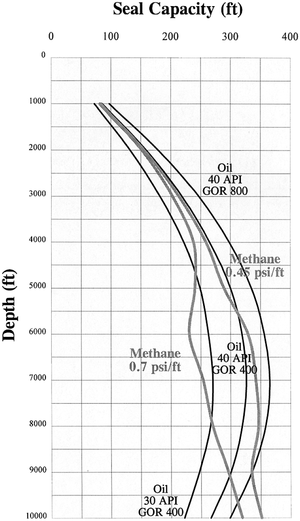Seal capacity variation with depth and hydrocarbon phase
| It has been suggested that this article be merged with [[::Seal capacity|Seal capacity]]. (Discuss) |
| Exploring for Oil and Gas Traps | |

| |
| Series | Treatise in Petroleum Geology |
|---|---|
| Part | Predicting the occurrence of oil and gas traps |
| Chapter | Evaluating top and fault seal |
| Author | Grant M. Skerlec |
| Link | Web page |
| Store | AAPG Store |
Seal capacity is controlled by the physical properties of both the seal and the hydrocarbon. Because the seal alone does not control seal capacity…
- It is possible to trap more gas than oil despite the higher buoyant pressure of gas,
- At depths below 9,000–10,000 ft a seal is always capable of trapping more gas than oil, and
- The dominance of gas in the deeper parts of basins may reflect seal capacity as well as maturation.
Changes with depth[edit]
Compaction and diagenesis during burial cause a progressive reduction in pore throats in most seal lithologies. In addition, the interfacial tension of the hydrocarbons changes with depth and affects seal capacity. Most importantly, the interfacial tension of oil and gas changes at different rates.[1][2]
Seal capacity for oil and gas[edit]

Because the interfacial tension of gas increases at a different rate from that of oil with depth, it is possible to trap more gas than oil. Figure 1 shows the seal capacity (in feet) of a top seal for different hydrocarbon compositions with depth (after Watts[1]). Curves show the seal capacity for three different oils, ranging from 30–40° API and a gas-oil ratio (GOR) of 400–800. Methane has two different pressure gradients (0.7 and 0.45 psi/ft. The pore throat of the seal decreases with depth and compaction.
Below depth::9000 ft, the seal capacity is greater for gas than it is for any of the oil compositions. Even above depth::9000 ft, the seal capacity for gas is greater for some oil compositions. The seal capacity for gas is greatest at a normal pressure gradient and less for an overpressured gradient.
Gas and oil distribution in basins[edit]
Seal capacity rather than maturation may cause the deeper portions of some basins to be gas prone. Traditionally the deep, gas-prone parts of many basins have been interpreted to be a result of increasing maturation. An alternative explanation is that seals at greater depth are more effective at trapping gas than oil.
Gas loss by diffusion[edit]
Diffusive loss of gas through a top seal can also limit seal capacity.[3][4] Seal capacity is not simply related to the displacement pressure. Although diffusion can be important in entrapment of gas, diffusion coefficients for oil are so small that diffusion does not affect seal capacity relative to oil.
Estimates of the diffusive loss of gas in the McClave field, Colorado, demonstrate that 57 bcf of gas can diffuse from a trap in only 0.5–5.0 m.y.[4]
See also[edit]
- Seal capacity
- Seal capacity of different rock types
- Seal capacity and two-phase hydrocarbon columns
- Seal thickness
- Fault-dependent leak points, continuity, and charge
References[edit]
- ↑ 1.0 1.1 1.2 Watts, N., L., 1987, Theoretical aspects of cap-rock and fault seals for single and two-phase hydrocarbon columns: Marine and Petroleum Geology, vol. 4, no. 4, p. 274–307., 10., 1016/0264-8172(87)90008-0
- ↑ Schowalter, T., T., 1979, Mechanics of secondary hydrocarbon migration and entrapment: AAPG Bulletin, vol. 63, no. 5, p. 723–760.
- ↑ Leythauser, D., R.G. Schaeffer, and A. Yukler, 1982, Role of diffusion in primary migration of hydrocarbons: AAPG Bulletin, vol. 66, no. 4, p. 408-–429.
- ↑ 4.0 4.1 Nelson, J., S., Simmons, E., C., 1995, Diffusion of methane and ethane through the reservoir cap rock: Implications for the timing and duration of catagenesis: AAPG Bulletin, vol. 79, no. 7, p. 1064–1074.